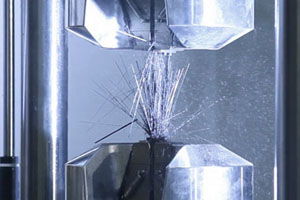Research Foci
Polymers and Composites for Severe and Extreme Conditions
 One of the CAPE Laboratory’s current thrusts is the development of composite materials for severe and extreme conditions. For example, as part of a program with the Army Research Laboratory (ARL), the CAPE Lab is developing light-weight, functionally graded composite structures to enhance dissipation of impact and thermal energy from blast-waves, projectiles, flames, and so on. This work involves the creation of hybrid composite materials, comprising nanocomposites and fiber-reinforced composites with tailored properties. Key research areas related to this thrust include the synthesis and formation of novel nanoscale and multiscale structured materials, application of multiscale computer simulations as predictive tools and advanced processing methods to control and localize structure formation and properties.
One of the CAPE Laboratory’s current thrusts is the development of composite materials for severe and extreme conditions. For example, as part of a program with the Army Research Laboratory (ARL), the CAPE Lab is developing light-weight, functionally graded composite structures to enhance dissipation of impact and thermal energy from blast-waves, projectiles, flames, and so on. This work involves the creation of hybrid composite materials, comprising nanocomposites and fiber-reinforced composites with tailored properties. Key research areas related to this thrust include the synthesis and formation of novel nanoscale and multiscale structured materials, application of multiscale computer simulations as predictive tools and advanced processing methods to control and localize structure formation and properties.
Polymer and Composite Materials with Multiple Sensing Capability
The CAPE Laboratory is developing polymer materials and composites with embedded sensing, diagnostic and communications capability. One of the current application areas is in helmets and other protective gear for military and security personnel, rescue workers, firefighters, sports players, and so on. Integrated, miniaturized, multiple sensing devices will provide the wearer, medical professional or command center with an array of critical information on hazardous environments, events and injuries met within the field.
Multi-Functional Composites
Multi-functional materials feature in the programs described above and are central to a number of areas of interest to the CAPE Laboratory. Integrated structures that can actively, and simultaneously, manage multiple advanced functions –(e.g., mechanical, electrical, optical, magnetic, thermal, biological) can potentially be realized through the addition of nanoparticle combinations at low loadings and/or through the design of layered composite and nanocomposite materials with functionally-graded properties. Investigations in this area involve polymer composite systems comprising fibers and particles with a range of chemical compositions, surface functionalities, length scales and geometries and employ both experimental studies and computational modeling methods.
Advanced Processing of Thermoset and Thermoplastic Composites
The high fracture toughness of thermoplastic polymer composites is well recognized, and significant improvements in the strength and stiffness of these materials are allowing them to challenge the predominance of thermoset composites in a number of demanding markets – even aerospace. Further advantages of thermoplastic composites include the ease of re-shaping or remolding (e.g., stamp forming) and their relatively benign environmental impact. There are nevertheless numerous challenges in designing cost effective processes that optimize composite properties, and the CAPE Laboratory is investigating and developing novel thermoplastic composite technologies, especially high throughput, “continuous fiber” processes. The lab is also starting to explore novel compounding and mixing processes for the addition, dispersion and alignment of carbon nanotubes and other high aspect ratio nanoparticles in the polymer melt; and methods to efficiently produce hybrid thermoplastic-thermoset composites with tailored properties.
For both thermoset and thermoplastic polymer composites, the lab is investigating and developing processes to provide greater diversity and control of structure. One such method involves precision placement of nanoparticles and other additives in composite structures to impart selected properties (e.g., reinforcement, abrasion resistance, electrical conductivity, magnetism, chemical functionality) at localized regions of the composite part. This approach promises to provide enhanced composite functionality at reduced cost.
Biocomposites
The development of materials from biopolymers is emerging as an important contributor to minimization of energy consumption and waste generation, as well as providing new opportunities for the design and engineering of products with exceptional properties and applications from automobile components to bone replacement. The CAPE Laboratory is involved in the development of composites incorporating, or derived from, natural polymers that have the potential to replace petroleum-based composite materials in a number of commercially important markets. For example, the CAPE Lab is supporting and contributing to research selected by the Center for BioEnergy Research and Development (
CBERD) on the utilization of solid lignin particles – co-products of the conversion of lignocellulosic biomass to ethanol – as property-enhancing composite additives.
Rapid Tooling and Prototyping
The CAPE Lab has the capability of moving efficiently from computer-aided design, to tool assembly, to prototype actualization, and our composite engineers continue to develop and refine these processes and system interfaces.